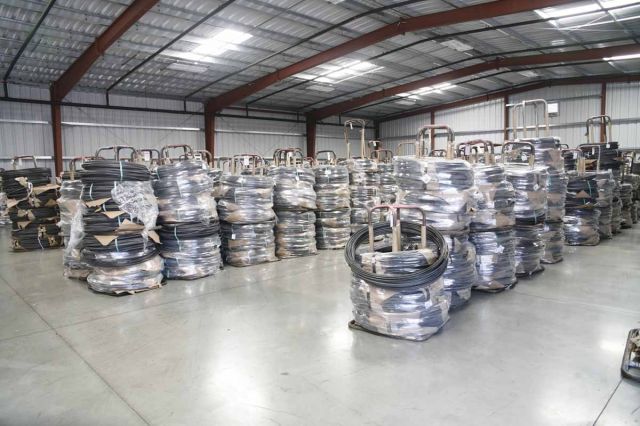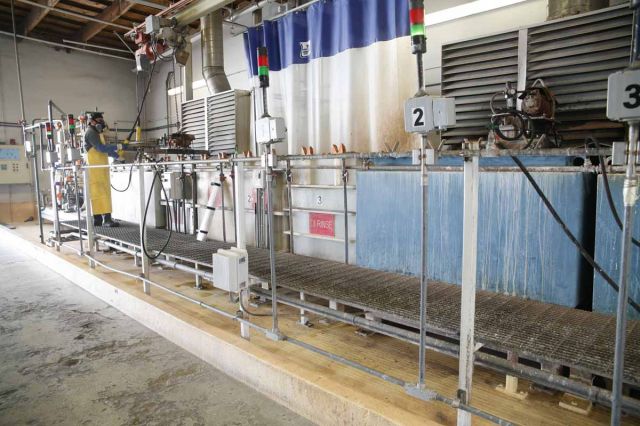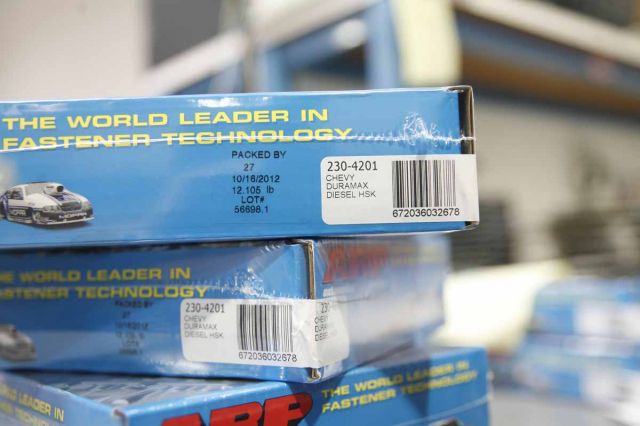If you’ve been around any kind of high-performance engine, you know the name ARP. Short for Automotive Racing Products, the company was started by (and is still owned by) Gary Holzapfel back in the late ‘60s when he realized there were no commercially available studs and bolts up to the unique challenge of racing. He had a history in making aerospace-level fasteners and started a racing-specific bolt making shop in his Southern California garage to address that concern. The company now has several buildings in Santa Paula and Ventura, California, with more than 115,000 total square feet where raw steel goes in one end and fully finished fasteners come out the other.

Point at any high-end race car (and most entry level home builds as well) and you’ll be able to find ARP fasteners on it. ARP makes a fastener for virtually any part on a car, and supplies specialty hardware to top Formula 1, IndyCar, NASCAR, and NHRA teams. Even John Force is one of their endorsers.

This is one of ARP’s many buildings that account for 115,000 square-feet of space. This one is in Paula, CA, and includes the company’s renowned Hozy’s restaurant in the front part of the building.
ARP’s director of sales and marketing and general “Jack of all trades” Chris Raschke gave us a tour recently and explained all the complicated steps a fastener goes through from raw bar stock to a finished piece of jewelry that gets the ARP stamp.
There are other bolt companies out there. When asked why ARP was better, Raschke said, “Everything ARP makes is to a recipe, and you have to follow that recipe. If somebody says, ‘I can make an 8740 rod bolt just as good as ARP’…if you look at it like a chocolate chip cookie, you can go out and buy a premix and get poor quality chocolate chips, and follow the recipe, and you’ll get a cookie in the end, maybe. But the ARP way is to purchase the finest ingredients, follow the recipe very carefully, and you’ll come out with a better chocolate chip cookie.”
Good analogy there, and something to remember when choosing any high-end part of any kind over cheaper versions of the same. Now, here’s how ARP makes its fasteners.
The Raw Material
In order to ensure optimum quality control, ARP controls all aspects of the manufacturing process, from start to finish, in-house. If something is wrong with a fastener, ARP is quickly able to figure out why and fix it, instead of being at the mercy of an outside contractor. The process begins right at the foundry, where ARP orders only premium grade materials, including several proprietary alloys. The ever-popular 8740 chromoly steel, for example, comes from the mill in four distinct grades. The lowest is “commercial,” which is followed by “aircraft quality.” ARP uses only the top two grades (SDF and CHQ), which cost twice as much but provide for defect-free fasteners. These materials come in bar stock (for studs) and huge coils (for bolts).

This is the 9,000 square-foot materials storage warehouse in Santa Paula, California where the various coils of raw metal come in from Carpenter Technology in Reading, PA. Raschke said, “It’s the most premium foundry in the world today. They are the top-of-the-line as far as trick steel bar stock and coils.”
Hot and Cold Heading
Transforming raw material into a fastener begins with “hot” and “cold” heading processes, where the head of the bolt is formed to the shank, which supports the threads will eventually go. The coiled raw material is fed into big, insanely powerful machines, straightened and cold forged or induction-heated and formed under tons of pressure.
The material coil is loaded onto this big cold-heading machine where it gets straightened and cut off to the proper length for whatever fastener is being made, then under intense pressure from a high-speed press the head is formed.
Left: This shows a cut-off piece of raw stock and the 'bolt' as it comes out of the machine. Right: There are quite a few cold heading machines at ARP; this one is currently set up to work with big 5/8-inch material. Notice the clean, polished floors and how the machines look really good. Every building is kept super clean and the machines are regularly rebuilt, most even getting new paint jobs.
This is a Toco long-stroke, single-die, cold forging machine that can make a part 12-inches long, like a long head stud. It’s typically used for material between .415- and .601-inch diameter. That’s Raschke’s 17 year-old son at the controls.
A look inside the Toco machine reveals the enormous flywheel and intricate inner workings. Right: The process of cold heading on this machine shrinks the bar stock this much during forming.
Left: Studs, like this head stud-to-be, obviously don’t get a head, so a hot heading machine superheats the stock and forms the hex that allows you to install the stud, and stamps it with the ARP logo. Right: Sometimes it’s necessary to hand stamp the bolts - a tedious and time-consuming operation done one bolt at a time. These are unfinished rod bolts.
Heat Treating
Following the basic shaping process, the material is heat-treated to desired levels. A gang of bolts, studs, nuts, or whatever is loaded into a rack and put into an internal quench furnace (IQF) where they are heated to a specific temperature for a specific time, then they go into what Raschke calls “the Maytag”, where they are washed off, then moved to a draw oven to bring the Rockwell hardness within spec. Different hardness levels are required for different strength levels depending on the part.
Clockwise from top left: Every ARP fastener goes through heat treating. They are loaded into racks (studs) or trays in thin layers for even heat soak and oil quench—if you put too many parts in a tray and stack them on top of each other, you don’t get good oil soak and quench. The flaming machine on the left is the IQF, supplied by in-house gas generators, and the others are the 'Maytag' cleaners and the draw oven.
Polishing
Big round vibrators loaded with various types of material are used to debur the un-machined fastener and polish the stainless steel ones.
This is the media storage building where the polishing compounds, be it walnut shells, cork, silicon, or other material, are stored. Here’s just one of the polishers used for a large amount of fasteners.
Centerless Grinding
The Grinding Department is where all studs are centerless ground to ensure that they are perfectly concentric. As many as ten machining steps are required to achieve this level of accuracy, and there are many machines in this area that are set up differently for whatever part is being machined at the time.

When the parts come out of heat treat, they are kind of scaly and get a bit of surface corrosion, so they’re loaded in a shot peen machine, one for cleaning and one for a class A certified treatment. Stainless steel .0017-diameter balls pummel the material to get it ready for grinding.
These are just a few of the centerless grinders at ARP. The operators are trained to set the machines up correctly and dress the wheels to get the correct shape on it and grind it to within .0001-inch diameter. They feed one fastener at a time into the grinder. The hand shot shows a stud that went to cold heading and got straightened, broached and stamped with the ARP logo, heat-treated, put through the shot peen process, then straightened again between two dies, and finally, ground on the outside diameter for size.
ARP is slowly moving to as many CNC machines as possible, such as this computerized grinder. An operator is still required to load each fastener individually and perform quality control as the machine is working. Right: This is George, who’s been with the company for 28 years, running a robotic machine for tri-rolls (thread rolling). The machine measures each part optically to verify that the grind shop did its job, then puts it into an induction heater, then into the thread roller. Raschke said, 'The CNC doesn’t take the operator out of the machine, it just gives the operator more time to do quality control.'
Thread-Rolling
The thread-rolling operation (to MIL-S-8879A specs) is done after heat treat, which accounts for a fatigue strength up to 10 times higher than fasteners that are threaded prior to heat-treat. There are several different types of machines that roll threads, depending on the fastener.
Clockwise from top left: This is one of the many (we counted more than 20) thread-rolling machines on the floor of this shop. This is a mechanical (non-CNC) roller that's used to knurl the threads, such as in a wheel stud.
Nut Forging and Tapping
ARP manufactures nuts in a multi-step process that begins with raw material being fed into a giant forming device that “blanks” the hex and 12-point nuts and continues with highly sophisticated automated threading equipment that taps each nut with an accuracy of .001˝ (which is five times higher than the aerospace standard). This ensures an exceptionally close-tolerance fit between the bolt/stud and nut. A series of CNC-threading machines are used to accurately tap the threads in nuts. Tolerances held are five times better than aerospace standards.
Nuts then go to metal finish, including a black-oxide coating of chromoly or polishing stainless steel to a brilliant luster. Raschke told us making a nut is far more difficult than making a stud or bolt.
Coating
Steel rusts. That’s a fact of life, so any fastener exposed to air must have some type of coating, which ARP gives its bolts and nuts. Of course, stainless steel does not rust or overly corrode, but a stainless fastener looks better if it’s polished or coated in some way. ARP offers most fasteners either polished or coated with a black oxide that looks almost like anodizing, but is really nothing more than an appearance item. Raschke calls it “accelerated rust.” But they look good when you use them.
R&D And Quality Control
A series of special checking devices are employed to monitor the quality of threads. For every thread size, there is a checking device, and several steps to quality inspection.

After thread rolling, some fasteners get a black oxide coating that is strictly for appearance, with no protection against rust and corrosion. Raschke called it “accelerated rust.” That’s why you’ll find some header bolts that install nice and black and end up rusty after a few months.
This is the quality control room to check every lot of fasteners for accuracy. Each microscope and measuring tester gets a 6-month inspection. This is a 'comparator,' which is basically a high-tech micrometer, optically measuring a bolt for diameter, angles, etc. The final, 100-percent quality check is done by hand. Raschke said, 'These ladies are the last line of defense to make sure we have the quality in the part that ARP wants to produce before it goes into your engine.'

This is one of two different machines that runs every hundredth part in a lot for strength in order to certify it. It tests them at 15,000 pounds, 7,000 times a minute. This one tests tensile strength. Raschke said, ‘All we do here is rip stuff apart. It qualifies the strength of the part. Think of a boxer—this machine tells you hard you can hit your opponent and how many rounds he can go. You can’t be the toughest bad-ass guy on earth and fall down on the first punch. You have to go 13 rounds.’ When a small part breaks, it might make a ding, but something like a 5/8-inch bolt breaks with such violence that it might make the very heavy machine jump off the floor and make the operator pee himself a little.
Shipping
When you manufacture a product, you must have a shipping department to send it out to buyers. Once an ARP fastener is finished going through the many steps of manufacturing, it gets stored in a warehouse in buckets with all the other ARP fasteners in a warehouse next to the shipping department. When you (or your local speed shop or engine builder) order a set of bolts, they’re boxed, weighed, and shipped right from ARP’s Santa Paula facility.
Clockwise from top left: After the parts are made, they are stored in this warehouse, next door to shipping. Is this the world’s biggest and best bolt bin? We’d say so. This is where the individual parts are categorized to package the kits prior to shipping. Every box is weighed and the shipping label goes on, then it’s to your door or speed shop. The scales are incredibly precise—if a washer is missing the scale picks it up and won’t allow the shipping label to print.

Something to remember and keep in your records: Every ARP kit is labeled with the lot number so if anything happens to a fastener, you can call ARP and find out why.
Conclusion
And that’s how ARP makes its fasteners. More complicated than you thought, huh? ARP stuff is often more expensive than the competitors and that cheap Chinese garbage, and you may be asking yourself, ‘Why should I pay extra for a bolt?’ Remember Raschke’s chocolate chip cookie analogy. Why would you eat at the French Laundry (Google it) when you could just have McDonalds? Think about it. ARP also makes more than fasteners for race and performance cars. While we were there, we saw some super-secret bolts, made for a local aerospace company, about which Raschke said, ‘You didn’t see this.’ They offer serialized fasteners for the top Formula 1 and IndyCar teams, and who knows what other applications we don’t know about. We wouldn’t be surprised if there were ARP bolts in the CIA’s spy planes that are watching you right now.























































